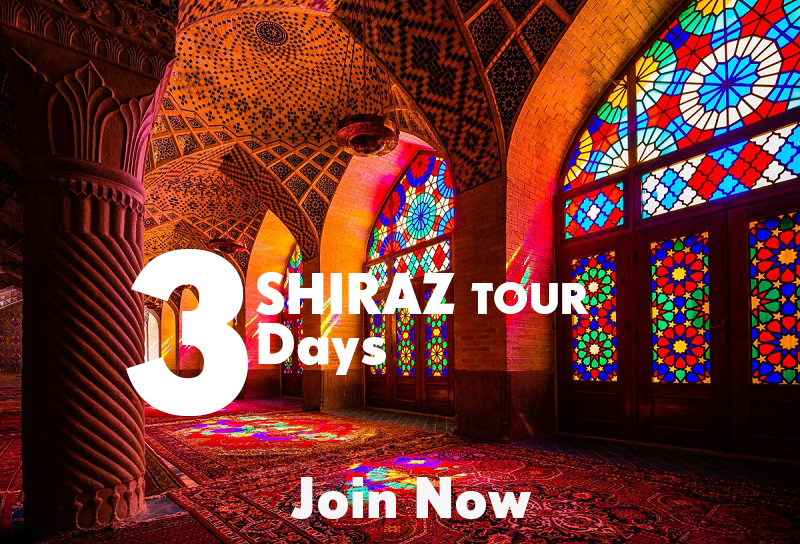Shiraz is the ancient city of Love and Literature and the birthplace of first paradigms of marvelously attractive Persian Gardens. It is popular for the residents’ hospitality and warmness and many historical and ancient sites. The old polis of Persian Empire is located near Shiraz, presenting the glory of a nation. You would be fascinated by the magnificence of the city. Here is the list of top things to do in Shiraz.
- Zand (Vakil) Complex: A magnificent complex from Zandiyeh era Including Citadel, Bath, mosque and traditional Bazaar located in the city center. It is for sure a symbol of the Zand empire glory which is important in terms of architecture and art.
The Arg of Karim Khan (Karim Khani Citadel): The castle formed of the Iranian traditional building and yard in interior part and resembles to medieval fortress from exterior view. In one of the rooms you will face some Statues that is like retelling you the story of their lives. In spring the orange tree blossoms’ aroma fills up the air.
Bath of Karim khan: An Iranian traditional bath turned into a museum, it is full of statues that introduce you to Iranian culture and traditional lifestyle.
Vakil mosque: The eye-catching interior decoration is originated from Iranian architecture. The porch and court are decorated with typical Shirazi multicolor tiles called “Haft Rang”. Due to its artistic design, you have seen beautiful photos of this mosque.
Traditional Vakil bazaar: The Bazaar was the main store center of Shiraz that has kept its traditional and old atmosphere. Strolling through the corridors gives you the feeling of being in hundreds of years ago and buying all kinds of Persian rugs, spices, copper handicrafts and antiques as Iranian ancestors did.
Sassanid Archaeological Landscape
- The City of Literature: Shiraz is the birthplace of two outstanding Iranian poets, Hafez and Saadi. Their tombs in Shiraz are the symbols of Persian rich literature.
Tomb of Hafez: Hafez is the most popular poet in Iran. He authored numerous ghazals expressing love, spirituality and protest. some of his poems are used as proverbs or sayings. Many of the poets like Goethe and Nietzsche have been influence by him. Hafez’s tomb is considered as one of the major tourist attractions.
Tomb of Saadi: Saadi was one of the major Persian poets living in the medieval period. He is so famous that has been quoted even in western sources. He is recognized for the depth of his moral and social thoughts reflecting in his poems. His tomb is located about one block from the tomb of Hafez. In addition to the holiness of the tomb, its exquisite mirror, tile works and marvelous Persian Garden make you get lost in an atmosphere full of spirituality.
[/vc_column_text][vc_masonry_media_grid element_width=”3″ grid_id=”vc_gid:1550903591077-7e54c3db-721b-10″ include=”8021,5473,8317,7375″][/vc_column][/vc_row][vc_row][vc_column][vc_empty_space height=”40px” el_id=”nasir-ol-molk-mosque”][vc_column_text]
- Nasir-ol Molk Mosque: This Qajari mosque is called by many names. Its popular name is “Pink Mosque”, due to the usage of considerable pink tiles for its interior design. It is also called the “Rainbow Mosque”, the “Mosque of colors” and the “Kaleidoscope Mosque”. The stained-glass windows capture the morning light and create a glorious dance of light on the floor of the mosque with wonderful Color combination that is absolutely breathtaking and is like standing in a kaleidoscope. This place is an interesting place for all photographers.
[/vc_column_text][/vc_column][/vc_row][vc_row][vc_column][vc_masonry_media_grid element_width=”3″ grid_id=”vc_gid:1550903591092-8635c609-a3f3-0″ include=”7876,5479,8020″][/vc_column][/vc_row][vc_row][vc_column][vc_empty_space height=”40px” el_id=”shiraz-gardens”][vc_column_text]
4. The city of Persian Gardens: The gardens in Shiraz are so pleasant to wander through. There are many magnificent paradigms of Persian garden in the city of Orange tree blossoms and Cypresses:
Eram garden: This historical Persian botanical garden is one of the UNESCO world heritage sites. It is like a Heaven with lovely cypress trees, a magnificent Persian palace and a fine stone edged pool reflecting the castle.
Narenjestan-e Ghavam: A Persian garden dates back to Qajar era located in the old part of the city. A garden full of sour orange trees with a traditional Iranian building. When you walk through the main entrance gate two rows of sour orange trees lead your eyes to a splendid building at the end of the path. The facade is decorated with bricks and the ceiling of the octagonal corridor has Muqarnas design. The Artistically decorated Mirror hall is surrounded by rooms symmetrically. The ceiling is covered with beautiful paintings in warm colors and lovely patterns.
Afif-Abad garden: This garden is one of old and scenic gardens of Shiraz. It was a royal recreation place during Safavid era. The decorations of building and garden are a mixture of Achaemenid, Sassanid, Zand, and Qajar styles. Today the garden is a military museum consists of gun museum and the Ebrat museum.
Nazar garden: The garden was created before Zand dynasty. Karimkhan, the founder of Zand dynasty, added some structures to it. This garden is full of Cypress and Orange trees, the Pavilion which is settled in the middle of the garden, is octagonal and called Kolah-farangi. Today it is known as Pars museum.
Jahan-Nama garden and Delgosha garden are the other two lovely gardens in the city.
- Takht-e Jamshid (Persepolis): This historic polis is located 57 kilometers north of Shiraz. UNESCO declared the ruins of Persepolis as World Heritage Site in 1979. It is a symbol of one of the most ancient empires named “Achaemenian”. Persians celebrated special events like Nowruz (Iranian New Year starts on the first day of spring) in Persepolis.
The archaeological site of Naghsh-e Rostam also referred to as Necropolis is located 12 km northwest of Persepolis and four Achaemenid kings are buried there. There are a number of reliefs in the site that the oldest one dates back to 1000 BC. A few hundred meters further there is another relief called Naqsh-e Rajab.
- Ghalat: This village is located 36 kilometers far from Shiraz in north west of the city. Having nice climate, eye-catching lands, winding alleys and the lovely sound of waterfall turn this village to a recreation area. Qalat is mountainous so, there are several houses in stair type of structure with tall trees that cover the view of these houses. Old churches, water mills and handcrafts like basket, Giveh (kind of shoe) and wood crafts are all attractive concepts in Ghalat. Walking in untouched sites of this region refreshes your soul and creates a fantastic moment. You can rest in traditional cafés and restaurants designed with woody decoration and taste Iranian food and have a cup of tea.
[/vc_column_text][/vc_column][/vc_row][vc_row][vc_column][vc_masonry_media_grid element_width=”3″ grid_id=”vc_gid:1550903591120-496a44e9-660c-7″ include=”6861,6373,6375,6372″][/vc_column][/vc_row][vc_row][vc_column][vc_empty_space height=”40px” el_id=”pasargadae”][vc_column_text el_id=”Pasargadae”]
-
Pasargadae: Pasargadae, a UNESCO heritage site, is the earliest capital of the Achaemenid Empire in Persia. This polis was constructed by Cyrus the Great. The archaeological ruins of its palaces, garden layout and the tomb of Cyrus form an eminent example of the first stage of the evolution of royal Achaemenid architecture.
Pasargadae is located 140 kilometers north of Shiraz and the excavated sites you can visit are the tomb of Cyrus the Great, the remains of Tall-e Takht fortified platform, the remains of Private and Audience palaces within the Four Gardens and Mozafari Caravanserai near the tomb.
- Outstanding Mirror Work: Utilizing the incredible mirror work in the interior decoration of the holy shrines and even traditional houses is so impressive that attracts every visitor.
Shah-e Cheragh: The third holiest Iranian shrine with picturesque and breathtaking design. Inside the building is decorated with charming mirror works that makes your mind dazzle.
Ali-ebne Hamze: The shrine is charming from the courtyard garden. The interior decoration is eminent with mirror tiles utilized on the walls and domed ceiling.
Ghavam house: The traditional house located in the Narenjetan e Ghavam garden. The mansion enriched with outstanding tile works and amazing mirror art. The mirror hall is a real memorial of Qajar era. Its architecture is symmetrical, the floors are decorated with gorgeous tiles and the walls are designed with attractive plaster work.
- Sassanid Archaeological Landscape: The Sassanid landscape that is added to UNESCO world heritage sites in 2018 consists of eight archaeological sites located in the southeast of Fars Province in three geographical areas i.e. Firuzabad, Bishapur and Sarvestan. Among these sites is the capital constructed by Ardashir Papakan, founder of the dynasty, and a city and structures of his successor, Shapur I.
It takes two or three days to visit the magnificent Sassanid landscape and the picturesque nature of the route. Also, you can get acquainted with the culture and hand crafts of the region. Even based on season you may visit nomad camps in the areas.
- Shiraz Bon Appetite: Today Persian culinary is popular all around the world and every city in Iran has its own traditional food. Here is a Shirazi full course on the table.
Shirazi salad, the best appetizer ever: This juicy salad becomes everybody’s favorite. The mixture of the Persian cucumber, tomato, onion and dried mint with homemade verjuice would balance the main dish flavors.
Kalampolo, the delicious main course: Kalam polo is a type of Shirazi cousin. A delicious mixed Persian rice. The basic ingredients are cabbage, meat, and rice. The meat is cooked as small-sized meatball. For sure taste this local food during your stay in Shiraz.
Faloodeh, the sweet dessert: Faloodeh or Paloodeh is an Iranian cold dessert that you find the best of it in Shiraz. It is often served with lime juice or rose water. It’s like white pasta consisting of thin vermicelli noodles mixed in a semi-frozen syrup made from sugar and rose water. You can taste a delicious Faloodeh and also traditional Iranian ice cream in the shops behind the karimkhan citadel.












